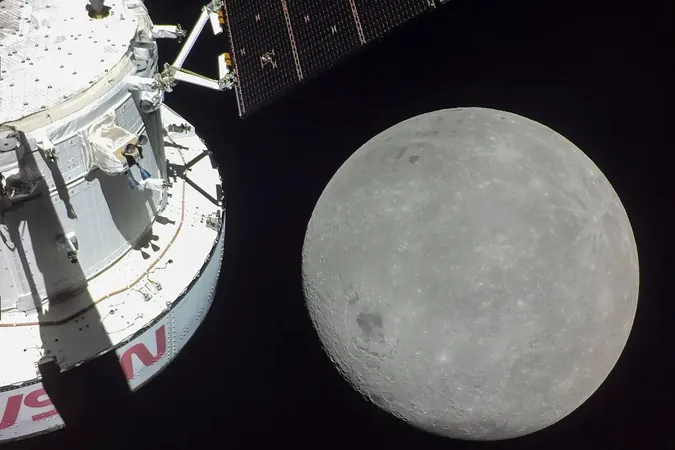
Elephant Seal Colonies in Argentina Begin Long Recovery After Devastating Avian Flu Outbreak
2024-11-22
Author: Nur
Recovery Signs in Elephant Seal Colonies
In a glimmer of hope for marine life in Patagonia, reports indicate that an epidemic of avian flu affecting southern elephant seals is showing signs of decline. This follows a catastrophic wave of infections that has severely affected seal populations over the past year and a half. Recent coastal surveys conducted by researchers have revealed no new cases of the deadly H5N1 strain, but the path to recovery for the nearly decimated colonies has just begun.
Origin and Impact of the Outbreak
The H5N1 influenza first emerged in southern elephant seals (Mirounga leonina) alongside other marine birds and mammals back in August 2023. The outbreak spread rapidly across multiple provinces in southern Argentina, prompting a flurry of research efforts to understand the impact. With new cases now dwindling, the focus is shifting towards monitoring the most affected colonies as they attempt to rebuild their populations—a process that could take decades.
Current Situation and Challenges
Valeria Falabella, director of coastal-marine conservation for the Wildlife Conservation Society (WCS) Argentina, confirmed, “Recent surveys in the province of Chubut showed no avian flu-related deaths. However, the concerning news is that the count of reproductive females remains alarmingly low.”
In a grim statistic, the Valdés Peninsula coastline, a key breeding ground for southern elephant seals, witnessed the deaths of 17,400 out of 18,000 newborn pups at the end of last year, according to a December 2023 study published in Marine Mammal Science. Normally, the average mortality rate is about 180 pups. The research characterized this spike in mortality as “catastrophic.”
Transmission and Effects on Ecosystem
Scientists believe that the flu transmission to marine mammals began with South American terns (Sterna hirundinacea), which predominantly affected elephant seals but also impacted sea lions (Otaria flavescens) and fur seals (Arctocephalus australis). Fortunately, fears of the virus spreading to predators like orcas (Orcinus orca) have yet to be realized.
H5N1 is a global menace, existing within avian populations, causing outbreaks in livestock across the United States, and occasionally jumping to marine mammals in South America. Rarely, it has also infected humans through close contact with the carcasses or infected animals.
Social Dynamics and Monitoring Efforts
Interestingly, the rampant mortality levels have disrupted social dynamics within seal colonies, as noted in a study published in Nature Communications. The ecosystem has seen less dominant males stepping in to replace deceased alpha males, along with a scattered distribution of females with their pups—who generally congregate more closely. Some pups were observed abandoned and in poor health.
Research programs have been consistently monitoring the elephant seal populations along the Valdés Peninsula since the 1980s, adopting a combination of land-based and aerial survey methods. This year, researchers reported no signs or symptoms of avian flu among the seals.
Hope and Caution for Future Breeding Seasons
“We were bracing for another outbreak,” Falabella stated. “The absence of cases this season is a stroke of luck; another incident like last year could have been catastrophic for the population.”
Nonetheless, the absence of illness doesn’t mean recovery will be swift. This breeding season has already shown a reduction in overall elephant seal numbers of up to 66% in some areas when compared to the previous year, with adult females declining between 30% and 70%. The number of weaned calves plummeted by a staggering 82%—a direct consequence of last year’s mortality spike.
Researchers now suspect that adult mortality rates may have been underestimated, as many sick individuals were able to leave the shore to hunt but ultimately perished out of sight. Preliminary findings this year suggest the death toll among adults was indeed higher than initially thought.
Long Road to Recovery
The road to recovery for these colonies will be lengthy, with significant challenges ahead. Unfortunately, the WCS and other organizations currently have limited measures to assist. Continued monitoring for potential future outbreaks is essential, especially as different strains of avian flu circulate throughout South America. In neighboring Chile, various marine mammal species have also been affected.
As the breeding and molting seasons approach—a crucial period for recovery—Falabella emphasizes that without a few uninterrupted seasons and ample food resources, the colonies may struggle to rebound. “We’re cautiously optimistic yet hopeful this year,” she remarked, with the breeding season running from August to November.
Conclusion
The survival of southern elephant seals hangs in a delicate balance as they navigate the aftermath of this crisis. With diligent monitoring and a touch of luck, these majestic creatures may once again thrive along the stunning Patagonian coastline.



 Brasil (PT)
Brasil (PT)
 Canada (EN)
Canada (EN)
 Chile (ES)
Chile (ES)
 España (ES)
España (ES)
 France (FR)
France (FR)
 Hong Kong (EN)
Hong Kong (EN)
 Italia (IT)
Italia (IT)
 日本 (JA)
日本 (JA)
 Magyarország (HU)
Magyarország (HU)
 Norge (NO)
Norge (NO)
 Polska (PL)
Polska (PL)
 Schweiz (DE)
Schweiz (DE)
 Singapore (EN)
Singapore (EN)
 Sverige (SV)
Sverige (SV)
 Suomi (FI)
Suomi (FI)
 Türkiye (TR)
Türkiye (TR)